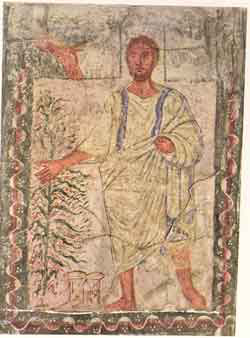Testing Abraham
The biblical narrative of Abraham's life (Genesis 11:26 – 25:10) is a series of challenges. Various midrashic sources developing out of the narrative identify these challenges as ten trials. Underlying all of them is puzzlement that the quintessential man of faith should be constantly tested. What was tested? Why did God need to test him? Didn't the omniscient God know what Abraham would do? Jewish commentators throughout the ages have wrestled with these questions and answered variously. Artists, perennially fascinated by Abraham's life, create visual midrash, illuminating and interpreting events in his life, even unaware of the tradition of the ten trials.
What is the meaning of these trials?
•Are they a learning process to refine Abraham?
•Are they tests of his worthiness?
•Are they opportunities to reward him?
•Or are they simply crises?
The earliest appearance of the word "test" comes from Old French, meaning a vessel, a cupel, in which precious metals were refined. The traditional view of the trials is a refining of the relationship between Abraham and God; our inclination is to also evaluate his relationship with others (family, foreigners, etc.), and his commitment to morality.
1. Abraham in Ur: Genesis 11
The first of Abraham's trials is midrashic rather than biblical, apparently because the Bible was not interested in miraculous infants. In the legends about his beginnings, Abraham first survives the royal edict to slay male infants in fear of the birth of a religious subversive. In isolation he discovers the true God and then challenges the beliefs of his father and his king and finally is saved from martyrdom. Theses legends of his youth were probably generated by the need to answer the question: How did Abraham become the first person to discover the One God? The answer they provide is that because of the threat to his life and his abandonment, he was not exposed to the religious fallacies of his society. His trial was living or dying with his Truth.
The story of Abraham's breaking his father's idols is so well known that most people don't realize that it's not in the Tanakh. In one of the earlier versions Abraham is left to mind the shop of his father Terah, the idol maker; Abraham first foils the sale of his wares and then destroys them.

Abraham breaks the idols of Terah
Alexander K. Floersheim Haggadah, Amsterdam Haggadah,
1737 1712
In the illustration from a Moravian haggadah of 1737, based on the printed Amsterdam haggadah of 1712, Abraham is smashing his father's idols inside the walls of Ur, while outside the walls three men kneel before an altar. Comparison with the Amsterdam model (above right), clarifies that this picture is an illustration of the haggadah's text recounting that originally (מתחלה) our ancestors were idol worshipers when they lived beyond the river (Joshua 24:2). In the original 1712 version, there is a river and a viaduct with numerous passages; in the 1737 version, the river has disappeared and the viaduct has become a solid wall separating Abraham from the idol worshipers. On the other hand, in our Moravian version, Abraham has a hat that lies on the ground near by. The worshipers also have hats, indicating that they, like Abraham, are our ancestors. Thus, the later version emphasizes the separation between Abraham and idol worship, rather than his exodus from Ur beyond the river.
A subsequent midrashic episode brings Abraham into confrontation with the god-king, Nimrod, builder of the tower of Babel and enemy of God. The midrash creates a theological disputation between Abraham and Nimrod, which ends, as in Christian Spain, with Abraham's spiritual victory rewarded with a death sentence.
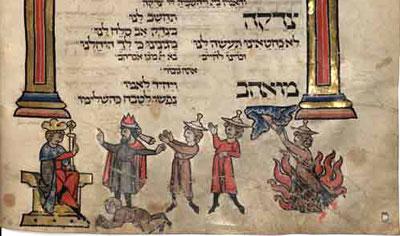
Leipzig Mahzor, Abraham in Nimrod's Furnace, ca.1320
In our picture, Nimrod is seated on his throne; before him stands Terah—seen by some midrashim as a supporter of the evil king—and his three sons. At Terah's feet lies Haran, who died "in his father's presence" according to the Genesis 11: 27, having been burnt to death by Nimrod, according to the midrash, because of his feigned belief in God. Behind Terah, stand Abraham and Nachor. On the right, Abraham is saved by a divine hand extracting him from the flames. This particular form of execution is generated in the midrash by the name of Abraham's home town, Ur, which in rabbinic Hebrew also means fire. Our illustration, placed along side a Yom Kippur liturgical poem glorifying Abraham's faith in God, seems to reflect the persecutions that Jews endured in Christian Europe during the Middle Ages.
Thus in these two pictures, Jewish artists expressed their admiration of and identification with Abraham in his role as believer and activist.
2. Lekh Lekha: Genesis 12
The second trial in our counting is לך לך the biblical portion in which Abraham is commanded by God to go forth from "his land, his next of kin and his father's house". The two words in Hebrew constitute an expression that has elicited much interpretation in the history of Jewish commentary. Some of the midrashic sources (see below) stress the disorientation implicit in the parasha and in these words – Abraham has been uprooted from his homeland and has lost his parents; he then is commanded to go to an unknown land. His trial is in his ability to withstand such loss of grounding and remained focused on his mission.
The two words look identical, inviting an interpretation that separates them: לך means go out and לך means go in (to yourself). The definition of the spiritual journey requires the two way movement; the hero goes forth and at the same time goes inward to search for meaning.
In Dali's painting, God's presence in the command לך לך is seen in the topographical map of the promised land and its aura, which creates the silhouette or negative space forming Abraham's profile.
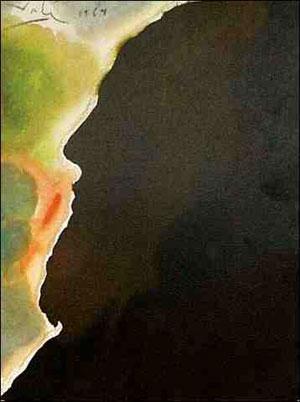
S. Dali, Biblia Sacra, Abraham Father of many Nations, 1964-67
Or you can see Abraham's dominant shape giving form to the amorphous potentialities of the unknown land. This dual view of the Dali work enables us to see the dual meaning of לך לך, go forth as you go into yourself.
Anthony Dubovsky also creates a "before and after" by cutting his painting into two distinct sections.
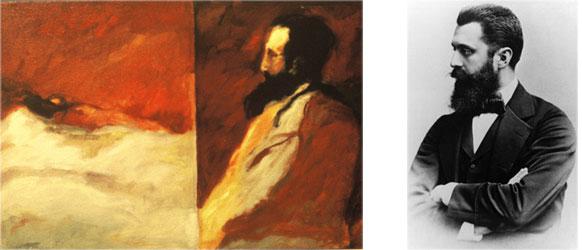
Anthony Dobovsky, Abraham, 1992 Theodor Herzl, 1898
The introspective Abraham's forehead and chest are bathed in the light of the divine command. Abraham's profile evokes the familiar image of Theodor Herzl, pondering another Lekh Lekha. The larger half suggests desert, fire, sacrifice and trauma of the external journey. A Midrash in Bereshit Rabba recognizing the anxieties associated with travel, compensates Abraham with a triple blessing. He and his destination (or destiny) are painted in the same colors, stressing their interrelationship, if not their identity.

Jo Milgrom, Married to Mr. Lekh Lekha
The Makings of Visual Midrash in three parts: La Familia Sagrada: The Jewish Holy Family, Part 1
A small suitcase poked out of the trash. Three distinct items fell out of it: heel plates, broken hinges, and half a scissors. ( Once upon a time you affixed heel plates to prevent the heels of your shoes from wearing down). In any case, since found objects are the random sources of my midrashic imagination I knew at once that heel plates meant wandering, that broken hinges meant a house coming apart, and that half a scissors which is a knife meant pain. Voila! An Akedah, the house of Abraham coming apart.
The open suitcase stands firm. Abraham occupies the left side,a dark figure wearing head tefillin and the yellow wiring of a head set because he is always getting ‘Lekh Lekha’ (Go Forth) messages from the Holy One. The heel plates and hinges are glued to the base of the suitcase. Mrs. Lekh-Lekha occupies the right side of the suitcase. She is a map of the ancient Near East shaped like a women’s busom. The half scissors hangs between her breasts. A child’s shoe dangles from the lock of the suitcase.
Sarah, the passive map upon whom the action takes place, is the true sacrifice of the Akedah. There is no critique in this work of obedient Abraham. He hears, and does. That the house of Abraham falls apart is subtly noted by the heel plates and broken hinges. Only in the biblical text do we learn that Abraham returns from the sacrificial altar where the substitute lamb was offered, accompanied by his servants …but without his son Isaac. Where is Isaac? Sarah dies in the opening of the next chapter. God, it seems, is satisfied with Abraham’s trial.
3. A Case of Mistaken Identity?: Genesis 12: 9ff.
The most perplexing of Abraham's trials occurs twice, when Sarah is put at risk in order to save Abraham. The couple, having just arrived in the land of Canaan, leave because of a famine. On approaching their foreign destination (Egypt, and later Gerar of the Philistines), Abraham lays out his plan Sarah saying, "Tell them you're my sister, so that it will go well with me because of you" (Genesis 12:13).

In James Tissot's orientalist presentation, Abraham is a bedouin sheikh, selling his concerns with tentative gestures, as Sarah listens incredulously.
In American performance artist Susan Benton's work, Sarah is masked, in order to accommodate Abraham's anxiety and his wish to profit from their situation
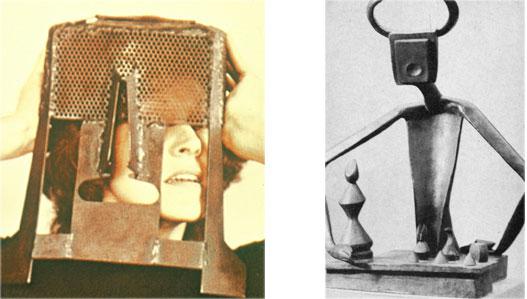
In fact, according to Genesis 20:12 Sarah is Abraham's half-sister or the daughter of his half-brother. So neither Abraham nor Sarah is lying. But Abraham does manipulate his wife and puts her at risk, in "a place where the people don't know God". The twentieth century surrealist Max Ernst, on the right, critiques such behavior: on the chess board, the king manipulates the queen.
The medieval Jewish commentator Nachmanides already dared to condemn Abraham's behavior toward Sarah as sinful, reflecting his lack of faith in God, for which his descendants were punished with extended enslavement in Egypt.
A Byzantine ivory plaque plays out this complex story in its narrative sequence.

God appears to Abraham/ Sarah given to Pharaoh,
Cathedral of Salerno, ca. 1100
In the left panel, Abraham stands at an altar to receive God's blessing, now that he has arrived in the land of Canaan (Genesis 12:6-8). In the right-hand panel, Abraham and Sarah stand before Pharaoh, who is either receiving the weeping Sarah from Abraham or returning her. In either case, Sarah at the center right is parallel to the flames of the altar (center left): she is Abraham's sacrifice, prefiguring her ultimate sacrifice (her death associated with the Akedah, Genesis 23).
Does Abraham pass this test?
4. The Attack of the 4 Kings and the kidnapping of Lot: Genesis 14
Abraham's next trial is by combat, a role inconsistent with his pastoral image. His kinsman Lot, has been abducted by four kings; Abraham pursues them into Syria with just a small group of retainers, defeats them, rescues Lot and returns with much booty. On encountering the King of Sodom, Abraham refuses any reward as conqueror. What does the king of Sodom have to do with Abraham and Lot? Previously (Genesis 13) these kinsman had almost come to blows over water rights. Generously Abraham conceded to Lot the well-watered plains and agreed to withdraw to the hills; as it turns out, these plains were home to the infamous but wealthy cities of Sodom and Gomorrah. When four foreign kings attack the land of Canaan, this rich area is their natural target and Lot is taken prisoner.
As early as the fifth century, the mosaics of Santa Maria Maggiore in Rome show the parting of Abraham and Lot. On the right, Lot, his wife and two daughters are headed toward a city. On the left, Abraham and company are backed by a tent and tree, representing their rural environment. The two men look at one another with reluctance at their separation.
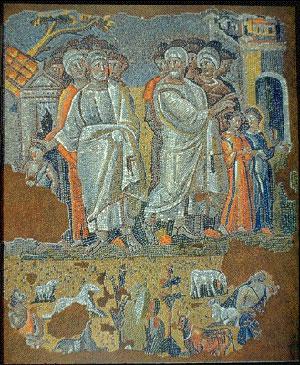
Abraham and Lot Part, Santa Maria Maggiore, 432-40
In the wild battle scene below, from an Italian illuminated Bible, a bright red figure draws us to the center. Among the cavalry, Abraham is identified as a civilian by his Jew's hat, beard and robe, as he embraces his rescued nephew Lot in the midst of fighting and dying cavalry.

Abraham's Battle with the Four Kings, ca. 1362
What is the trial in this episode? The traditional sources seem to be saying that the peaceful Abraham's willingness to do battle, trusting in God's aid, is the mark of his faith. But we might add that his test is how he deals with tension within his family and whether he maintains his family bond despite these tensions.
5. Progeny – and the covenant of pieces: Genesis 15

Vienna Genesis Bible Historiale, E.M. Lilien,
6th century 1372 1908
The trial of faith intensifies in Genesis 15 with a vision in which God, anticipates Abraham's gnawing fear of childlessness. God calls out,, "Don’t be afraid, Abraham, I am your shield and your reward. What comes out of your house will not inherit you, but what comes out of your loins! Go out and count the stars – that many will be your seed." From the purple calf parchment of the sixth century Vienna Genesis, to the twentieth century illustration by E.M. Lilien, Abraham views the stars in a dark night, comforted again by the improbable promise. The gesture in both is the gesture of receiving a gift: in the Lilien picture, Abraham holds his heart in grateful anticipation; in the Vienna Genesis, covered hands is the visual convention for receiving a gift. (In antiquity Roman soldiers would extend their covered hands to the emperor, to receive their salary, a measure of salt. Salary derives from sal, salt-). In the center, Abraham crouches in a trance before the split carcasses of the vision of good news and bad news. The good news confirms his possession of the land; the bad news forecasts the impending slavery of his descendants in Egypt.
6. Hagar and Sarah: Genesis 16
Abraham just worries about continuity, but Sarah takes the initiative, introducing her Egyptian handmaid, Hagar, whose hoped-for fertility will heal Sarah's barrenness.
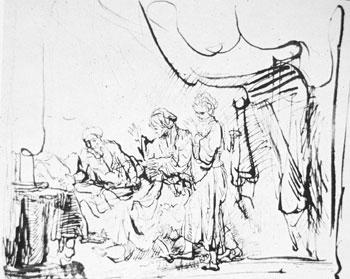
Rembrandt, Sarah presents Hagar to Abraham, 1643-44
In Rembrandt's pen and ink drawing of ca. 1640, Sarah, in the center, brings the demure Hagar, to the couch of the passive, reclining patriarch. Three gesturing hands define the complexity of this proposal. And three feet of Sarah and Hagar show them at a critical intersection. Two substantial breasts appear in the drapery, above and to the right, focusing the pathos of the scene.
A few months later, the same trio appears once more.

Rembrandt, Sarah complaining of Hagar to Abraham, ca. 1640
Hagar, proud and pregnant, no long downcast and demure is identified by the peacock behind. No longer the "fixer", Sarah, still in the center is bent and devastated, pouring out her wrath on the nonplussed master of the household.
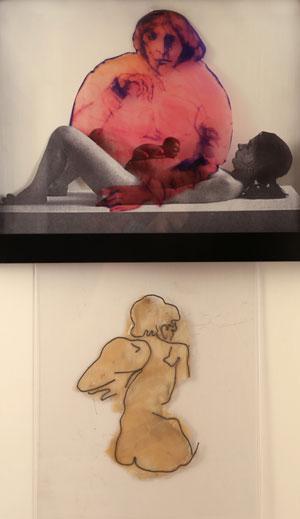
Jo Milgrom, Surrogate Mother
Lifting her head
The young mother
gazes on the miracle of birth
resting on her belly
In the Bible Hagar
Is a concubine
today she is a
surrogate mother
for the matriarch Sarah
whose entire adult
life was barren
frustration
The placement of baby Ishmael
(“God hears”) is perfect:
Sarah can easily imagine
he was really inside her womb
Adam Nordwall's statue "Split woman" expresses Sarah's dilemma.
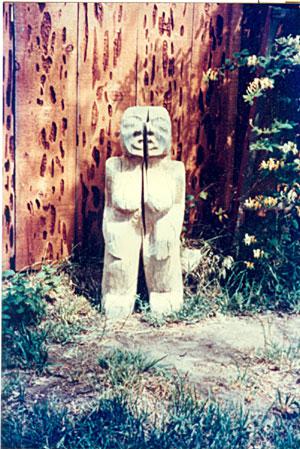
Adam Nordwall, Split Woman
At this point in Hagar's saga, Abraham mollifies Sarah: She's your handmaid, do with her what you will. Progeny notwithstanding, Sarah abuses Hagar, who flees.
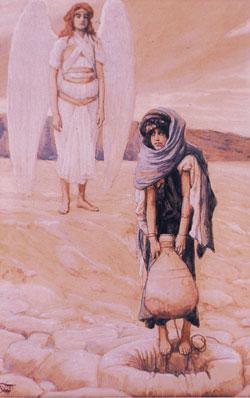
1896 - 1902
In Tissot's painting, an angel finds the pregnant child Hagar by a well in the desert, and tells her to return home and endure her mistress's abuse, because:
God will surely infinitely multiply your seed.
You shall call him Ishmael,
because God has paid attention to your suffering
In a rare depiction of her return, Pietro da Cartona portrays Abraham welcoming back a more mature, contrite Hagar with open arms, while Sarah looks on scornfully from a shadowy doorway. As opposed to Rembrandt's drawings, Abraham is at center stage, caught between the two women.
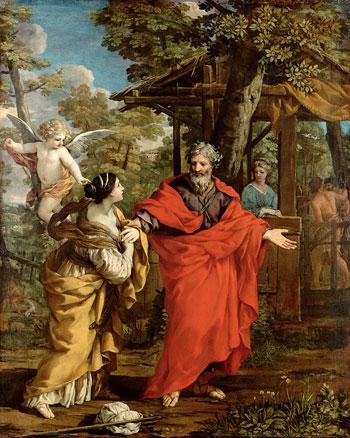
This trial can be understood in two ways: 1) Abraham's equinimity is challenged by a disturbed family dynamic or 2) Abraham's faith that God's providence will justify the subsequent exile of Hagar and Ishmael.
7. Circumcision: Genesis 17
Up to now the relationship between God and Abraham has been a promise; now it becomes a contract or brit. The verbal is now cut into the flesh.
The twenty-seven verses of Genesis 17 are teeming (13 out of 27 verses) with words connected with fertility: זרע 'seed', הרבה 'make many', הפרה 'make fruitful', ברך 'bless', etc. The word ברית itself appears in this chapter thirteen times out of the 17 total occurences in the Abraham narrative. The focus of the chapter is the circumcision rite, mentioned here ten times, the first occurrence of this practice in the Tanakh. Both here and in the context of agricultural law (Lev 19:23), the orla 'foreskin' is considered to be an obstacle to fertility. Thus circumcision is required to enhance human fruitfulness.
Two scenes appear in one of the few portrayals of this chapter in European art.
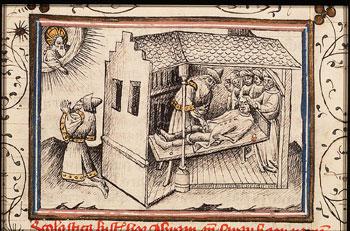
In this fifteenth century illuminated manuscript of Guiart des Moulins' Historical Bible, Abraham kneels before God outside, on the left, and receives the divine promise. Inside, on the right, we observe the ceremony of Ishmael's circumcision, attended by the men of Abraham's house. In order to concretize the involvment of all those "born in the house" (v. 23), a wall of the house is cut away exposing the interior. Finally, both Sarai/Sarah and Abram/Abraham receive new names to mark their new status. The heh in Sarah and Abraham emphasizes both the presence of God (ה') and the "muchness" 'המון' that is to come.
8. The Expulsion of Ishmael and Hagar: Genesis 21
In Genesis 21, after the long and difficult process of creating Abraham's family, that family begins to fall apart. At the baby Isaac's weaning party, Ishmael does something (מצחק) that evokes Sarah's rage. This something has been variously interpreted as sexual misconduct, idolatry or attempted murder (Rashi and others) or simply as childish mischief (Ibn Ezra and others). Sarah demands:
drive out this maid and her son,
he will not inherit with my son, with Isaac.
As opposed to his previous indifference, Abraham is outraged and only God's intervention sets the exile in motion. What is Abraham's trial? It can be understood as the dilemma of human as opposed to Divine love and it can be seen as a conflict between two human loves: the love for Sarah/Isaac and the love for Hagar/Ishmael.

Drost, a pupil of Rembrandt, was drawn like his master, to the expulsion of Hagar and Ishmael. In this portrayal, Abraham is filled with compassion for Hagar and for Ishmael both. The heavy black cloud over Abraham expresses his anguish over the forced exile. One hand caresses Ishmael, the other hovers toward the weeping Hagar. The stoop suggests both an altar upon which mother and child are being sacrificed, and intimates the missing presence of Sarah, usually standing in the doorway.
Jan Victors too, was a pupil of Rembrandt, from whom he learned the power of portraiture, especially the play of light and shadow. He chooses the moment of separation; all are present at the doorway, Hagar is already outside. Strong light illuminates her distressed face and wringing hands as she looks back to her home. Innocent Ishmael's head is capped with light as Abraham's hand hovers in blessing. The child's right hand reaching out to his father, calls our attention to Abraham's fist. Strong light moves us to Abraham's far-away stare. Lesser light illumines the tight-lipped Sarah, as usual in the doorway, the place of the manipulator. Small light focuses on her hands, one clenched fist and an assertive index finger, pointing Out. The totality of the painting is restraint, in comparison with Drosts's emotionality.
In our own times, the story has not lost its pathos. All the players are present in George Segal's painted plaster installation.
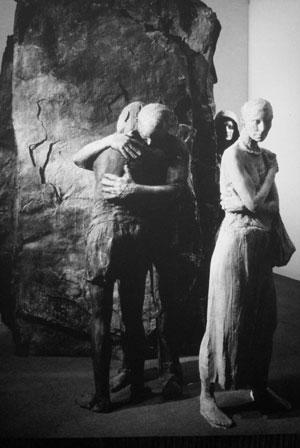
George Segal, Abraham's farewell to Ishmael, 1987
A modern family is breaking up. Father and grownup son embrace in parting. The other woman stands alone, embracing herself. The matriarch, the manipulator, supervises in the shadows. A large crack appears in the wall of separation.
In contrast to the victim we have seen until now, a defiant Hagar emerges from the feminist movement in the art of North Carolina artist Mickey Gault.
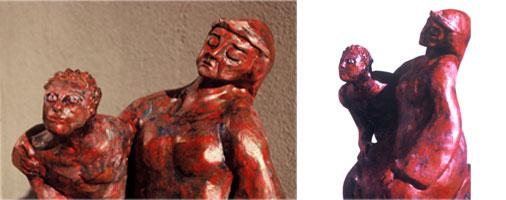
Mickey Gault, Hagar and Ishmael
While defiance is clear from her arched back in profile, Hagar's face reveals tragedy. The boy's bug-eyed look says fear, but his profile suggests urgency. None of the narrative details are present: not the home, not the family, not the water or bread. The red sculpture suggests a burning desert and high emotion. Gault's agenda is not Abraham's trial, but Hagar's.

Jo Milgrom, The Two Lives of Sarah Genesis 23:1
Larger than life behind the ankh
Sarah age 27 and Sarah age 100
Two lives on her collaged faces
inside the ankh
two imagined images
hover between breast and womb
hands tightly bound by the useless
cord emerging from her navel
waiting years of monthly periods
waiting to embrace the lad
asleep upon her bosom
of the not yet almost mother
below the ankh old and young
Sarah’s hands reach a tattered IDF beret
From which dimly appear the eyes
of the father who sacrificed sons
alien to each other and to him
they come together only to bury the old man
the true sacrifice of the Akedah
is Sarah whose death opens the next chapter
there is no happy end
Commentary: this entire visual midrash emerges from two possible readings of ”years of Sarah’s life” and “two lives of Sarah” (sh’nai haye Sarah); hence the young and old Sarah, the barren and fruitful mother, the old and young hands holding the tattered beret . Abraham is also a double. The public patriarch is a God obsessed giant; the private Abraham compromises his wife and destroys his sons. He barely appears in this sculpture; at the very bottom a profile and piercing eyes emerge from the edge of the deceased son’s beret.
9. Akedah – The Binding of Isaac: Genesis 22
Lekh lekha is the lead word of the Abraham saga, occuring twice. Once in Genesis 12, commanding Abraham to Go Forth from Ur "to the land that I will show you," accompanied by a promise of blessing and greatness. The second lekh lekha closes the bracket around the Abraham saga and unravels the blessing by commanding Abraham to Go Forth to sacrifice his son, Isaac. The "land that I will show you" becomes Moriah, the place of the altar. The blessing of future becomes the dread of the end.
God's words come tumbling down in Shraga Weil's silkscreen.
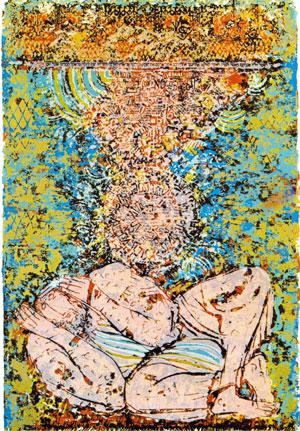
Shraga Weil, Abraham's Dream, 1970
From a line of text containing the lekh lekha, a hail of letters awakens Abraham, who covers his ears in dismay. A vague image of the Menorah descends from the passage cut from a printed Bible, while the flood of letters below suggests ripped newspapers, connecting the biblical narrative to the State of Israel and contemporary protest against sacrifice of sons. An impression of broken glass and shattered dreams pervades.
Avraham Ofek takes us on the journey to Moriah. Sparse lines and minimal detail speak eloquently.

Avraham Ofek, On the way to the Mountain, 1980's
Abraham and Isaac in the lead, followed by the two servants and the donkey, strain emotionally against the ascent as we observe from the side and behind. The figures of Abraham and Isaac are filled in, as is the wood loaded on the donkey, while the two boys are mere outlines. Diagonal movement stresses not only the ascent, but also the burden. The bare, harsh landscape and the threatening midrashic vulture convey a bleak mood; salvation is not in sight.
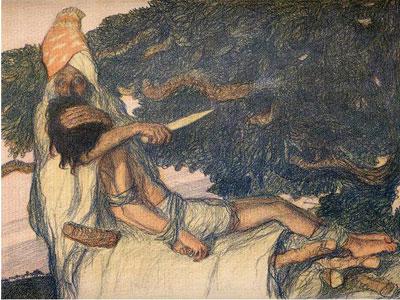
Abel Pann, Binding of Isaac, 1923
Paradoxic love and violence fill the scene in Abel Pann's painting of the Akedah of 1923. A distraught father, staring into space, caresses with one hand and wields a knife in the other. Neither the saving ram nor God's presence appears here, but rather a vast tree shadows across the background.
The three major moments of the Akedah are God's call to Abraham, the journey to Morah and the sacrifice, presented above. Jan Lievens, a colleague of Rembrandt, painted a fourth, rarely illuminated scene, a midrashic reconciliation of father and son.
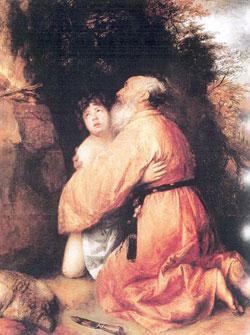
Jan Lievens, Abraham and Isaac, 1637
The biblical text (Genesis 22:19) speaks in the singular of Abraham's return from Moriah—Isaac is not mentioned—leading to midrashic conjectures about his whereabouts. Lievens creates positive closure, the embrace of Abraham and Isaac, with the slaughtered ram at their feet.
The reader has probably observed that Sarah is entirely absence from the Akedah narrative. However, the next chapter opens with the announcement of her death. It doesn't take much imagination for the Midrash to create a causal connection: The satanic rumour reaches her; the shock kills her. In Dore's engraving of 1865, the shrouded body of Sarah is placed upright in a niche within a burial cave.
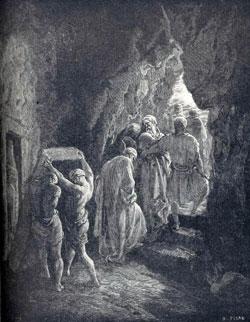
Two burial workers are pushing the stone door into place; once again, the shadowy figure of Sarah stands in a doorway. A group of mourners pull the reluctant Abraham toward the exit. Abraham looks back in anguish, perhaps in guilt.
Abraham and Isaac go their separate ways. Hagar will soon find a bride for Ishmael. Perhaps Sarah is the true sacrifice of the Akedah.
Abraham's life is characterized by many trials. Various rabbinic traditions record 10 trials (see Rambam on Abot and Pirkei deRabbi Eliezer), with variations on their identification, perhaps reflecting the statement in Numbers 14:22 that the people of Israel tried God ten times during the desert wanderings. Ten is a good round, typological number; we could find even more but our (ac)counting produces one less. The traditional approach to these trials is that they are tests of faith; our own reading of Abraham's story and the reading of many artists is that he undergoes tests of character. In both cases, it is not clear whether Abraham gets good grades.
For additional images on this subject see TALI Visual Midrash



